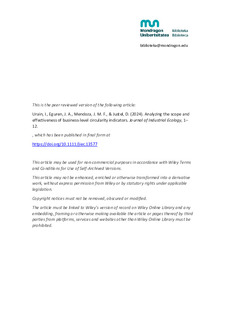
Título
Analyzing the scope and effectiveness of business-level circularity indicatorsAutor-a
Fecha de publicación
2024Versión
PostprintTipo de documento
ArtículoArtículoIdioma
InglésDerechos
© 2024 WileyAcceso
Acceso embargadoFin de la fecha de embargo
2025-10-31Versión de la editorial
https://doi.org/10.1111/jiec.13577Publicado en
Journal of Industrial Ecology Vol. 28. N. 6. December, 2024Editorial
WileyPalabras clave
Business functional areas
Circular economy
Circular business model
Resource efficiency ... [+]
Circular economy
Circular business model
Resource efficiency ... [+]
Business functional areas
Circular economy
Circular business model
Resource efficiency
Sustainability reporting
ODS 8 Trabajo decente y crecimiento económico
ODS 9 Industria, innovación e infraestructura [-]
Circular economy
Circular business model
Resource efficiency
Sustainability reporting
ODS 8 Trabajo decente y crecimiento económico
ODS 9 Industria, innovación e infraestructura [-]
Clasificación UNESCO
Estudios industrialesResumen
Research on circular economy (CE) reveals that companies have a large number of indicators at the microeconomic level. However, their scope is limited, as they lack sufficient knowledge to apply them ... [+]
Research on circular economy (CE) reveals that companies have a large number of indicators at the microeconomic level. However, their scope is limited, as they lack sufficient knowledge to apply them effectively. This is due to the difficulty of obtaining the necessary information and the weak connection with the functions of companies' functional areas. Knowing that organizations evolve over time, not only in terms of strategy development but also in terms of leadership, innovation, and structure, it is necessary for indicators to adapt to these needs. This study aims to analyze the impact of indicators on CE strategies and solutions, life cycle stages, and industrial functional areas, considering the Basque Country in Spain as a case study. For this purpose, a literature review has been carried out identifying applicable indicators and a study on the indicators that BC companies use on a daily basis. The analysis found that 67% of the indicators only consider a CE strategy and solution, while only 2.5% impact all life cycle stages. Additionally, it was found that the use of indicators in companies does not provide a global and holistic view of CE. This highlights the need to develop a new model of indicators that responds to the needs of companies. [-]
Colecciones
- Artículos - Ingeniería [761]




















